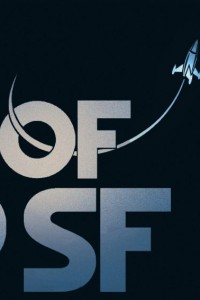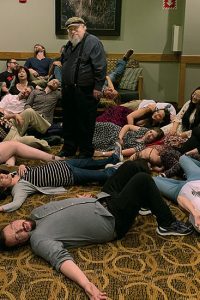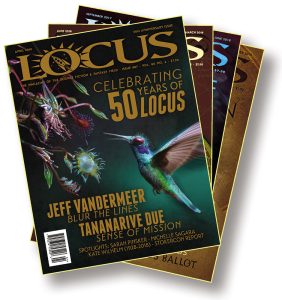Spotlight on Never Whistle at Night
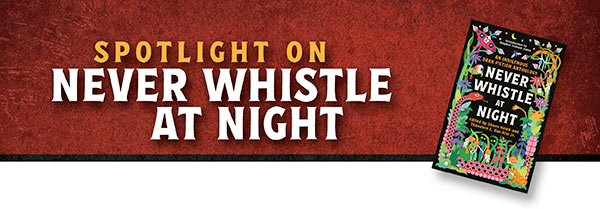
Shane Hawk is a Cheyenne and Arapaho horror writer and high school history teacher from California whose work has been featured in numerous anthologies and the stage. He is the co-editor of Never Whistle at Night, a groundbreaking anthology showcasing Indigenous horror stories that challenge and redefine the genre. Hawk’s writing is inspired by family lore, cryptid sightings, and the haunting legacy of colonialism. When he’s not crafting spine-chilling tales, Hawk enjoys spending time with his beautiful wife and their six-month-old daughter.
Theodore C. Van Alst Jr. (enrolled Mackinac Bands of Chippewa and Ottawa Indians) is the author of Chicago-set award-winning story collections Sacred Smokes and Sacred City; Sacred Folks, the final book in the trilogy, was recently published by the University of New Mexico Press in October 2024. He is the co-editor of the bestselling Never Whistle at Night from Vintage/Penguin Random House. His debut novel, The El, will be published by Vintage/ PRH August 2025. His work has appeared in Southwest Review, Chicago Review, The Journal of Working-Class Studies, Red Earth Review, Indian Country Today, and elsewhere.
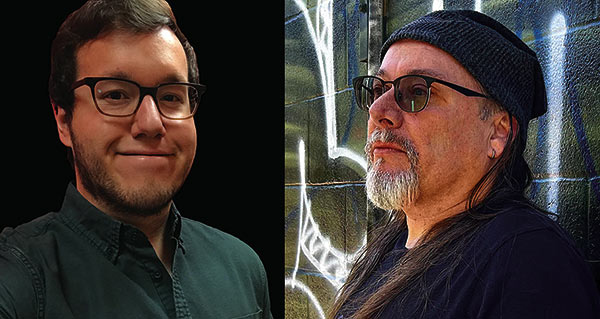
What inspired you to put together the anthology Never Whistle at Night?
Shane Hawk: It came out of this deep frustration with how our stories – Native stories – were either ignored or mangled by people who didn’t get it. Horror’s been part of our traditions forever. It’s not just ghost stories; it’s survival stories, cautionary tales, warnings wrapped in shadows. I wanted to take all that, amplify it, and let the world know: This is who we are when the lights go out.
Theodore C. Van Alst, Jr.: I think it would be easy enough to talk about numbers, about the lack of representation of Native folks in publishing but it’s much better to talk about stories and their importance in the world and the need to get those out there regardless of what statistics want to tell us. We wanted to tell our stories, felt that other folks would like to hear them, needed to see them, and let that drive our work.
What would you like us to know about this book, beyond the info on the publisher page?
TVA: There are some raw voices here, ones that like the actions and worlds they portray, come without warnings, trigger or otherwise. And they can end as abruptly as they start. The stories can be funny, and painful, insightful, and horrifying. Stephen Graham Jones’s intro does a whole lot to explain to readers what they’re about to experience in his own unique way, and I suggest spending time with what he’s had to say up front.
SH: This isn’t your typical horror anthology. It’s raw, messy, and unapologetically real. These stories cut deep – not just because they’re scary but because they hit on truths people don’t always want to face. Colonialism? Generational trauma? Survival in a world that’s constantly trying to erase you? Yeah, it’s all there, tangled up with monsters and ghosts. But it’s also about joy and humor – the stuff that keeps us alive even when things get dark.
How were stories sourced for the first book, and is the process similar or different for volume two?
TVA: We’re of the same mind in that we’d like to provide the best possible platform for new and emerging voices while giving space to established writers to stretch and explore new settings. For Part II, we’ve kept the same open-call and invite structure. As for ourselves, we’ve acquired new skills in organization and flow for a whole lot of reading and considering. The behind-the-scenes of putting together a top-notch anthology can be as challenging as it is rewarding.
SH: For the first anthology, we cast a pretty wide net. We invited some heavy-hitting Indigenous writers – even if they weren’t known for horror – because we knew they’d bring something fresh to the genre. On top of that, we held an open call for three months to let emerging voices shine. It was exciting, but man, it was chaotic. I was juggling auto-forwarded emails, Google Drive folders, and handmade spreadsheets like a madman. For the sequel, we stepped it up big time. We used Moksha to handle submissions, and let me tell you, that back end setup is a game changer. It keeps everything clean: rating stories, sorting them, building a long list – it’s all streamlined now. We’ve learned a lot, and the process runs smoother, but the heart of it is the same: finding those stories that stick with you long after you’ve turned the page.
You are both authors as well as editors. What does having published work as writers change about your editing processes?
SH: We know how brutal it is to put your soul on the page and then hand it over to someone else. That means we don’t just rip into a story for the sake of it. We want to build it up, not break it down. But we’re not here to sugarcoat anything either. If something doesn’t work, we’ll tell you straight, but we’ll also tell you how to fix it. We’ve been on the other side of the table, so we know what it feels like. That gives us a little more empathy – and a lot of respect for the process.
TVA: Submitting your own work to open calls, being rejected and accepted, having your writing edited, paying close attention to notes – all those things come into play as you work to make someone else’s story the best it can be. I’ve edited a single-author collection (Stephen Graham Jones in The Faster Redder Road) and now an anthology – they’re different processes to be sure – but the goals are the same even if the road is a bit different. It’s vital to take all we’ve learned and apply that at every step of the way. Care, concision, and heart make the stories shine.
What are some of your observations about Indigenous short fiction that have come out of working on these books?
SH: Indigenous writers don’t pull punches. We mix humor and heartbreak like no one else, and even the scariest stories carry this undercurrent of resilience. There’s this thread that runs through them, saying, ‘‘We’ve been through worse. We’ll make it through this too.’’ And the range is wild. It’s not just folklore or historical trauma – though those are there, and they’re powerful – it’s also futuristic, weird, experimental. It’s alive, constantly evolving, and it refuses to be boxed in.
TVA: It’s so exciting to see and hear all these voices that draw on so very much. The short form has always been my favorite and to have it expand in its tighter spaces has been amazing. Interior boundaries and rules snap under so many powerful stories that write themselves on their own terms. It’s been great.
Are there a few stories you’d like to highlight?
TVA: Setting the TOC was extremely difficult, but I knew Mathilda Zeller’s ‘‘Kushtuka’’ would be first. Once this amazing story took the One slot, everything started to come into place as the book traveled south and over and back up north again. And since I love stories from the north in particular, Richard Van Camp’s fully packed ‘‘Scariest Story… Ever’’ is great for drinking tea, eating cookies, and thinking deep winter night thoughts. Speaking of dark, Nick Medina’s ‘‘Quantum’’? Holy moly.
SH: For sure. Phoenix Boudreau’s ‘‘Hunger’’ hits you right in the chest. The Wehtigo isn’t just a monster – it’s a sharp metaphor for colonial greed and the destruction left in its wake. The story seamlessly blends traditional lore with a modern setting, showing how that hunger never really goes away, just changes form. Summer and Rain aren’t just fighting a creature; they’re reclaiming power through ancestral knowledge. It’s raw, terrifying, and unforgettable. Then there’s Nick Medina’s ‘‘Quantum’’, which hits just as hard in a totally different way. It’s a chilling look at blood quantum policies and how they’ve fractured identity within Native communities. The horror lies in how colonial rules have wormed their way into our lives, making people question what it means to be ‘‘Native enough.’’ Medina doesn’t hold back, delivering a story that gets under your skin and makes you think long after you’ve finished it. These two stories prove that Indigenous horror isn’t just scary – it’s meaningful, and it’s got serious staying power.
Is there anything else you’d like people to know about these books or other projects?
SH: These books? They’re just a crack in the door. There’s so much more to come – not just from me but from all the Indigenous writers who’ve been waiting to be heard. As for me, I’m knee-deep in the sequel to ‘‘Behind Colin’s Eyes,’’ and it’s shaping up to be a fever dream of fatherhood, climate chaos, and generational ghosts. It’s not just horror; it’s a punch in the gut. Stay tuned.
TVA: I’d like folks to know how much we appreciate their support and readership for Never Whistle at Night Part I, and that Part II is on the way. We’re super excited working through all these new stories and the focus on horror should be lots of fun. For myself, I’ve just had Sacred Folks come out to wrap up a Chicago-based trilogy of linked stories and I’m, wow, can’t wait, so cool to say out loud – my debut novel THE EL will be published by Vintage / Penguin Random House this summer. Oh, surprise, it’s set in Chicago. Hope folks dig it.
–Shane Hawk & Theodore C. Van Alst Jr.
 While you are here, please take a moment to support Locus with a one-time or recurring donation. We rely on reader donations to keep the magazine and site going, and would like to keep the site paywall free, but WE NEED YOUR FINANCIAL SUPPORT to continue quality coverage of the science fiction and fantasy field.
While you are here, please take a moment to support Locus with a one-time or recurring donation. We rely on reader donations to keep the magazine and site going, and would like to keep the site paywall free, but WE NEED YOUR FINANCIAL SUPPORT to continue quality coverage of the science fiction and fantasy field.
©Locus Magazine. Copyrighted material may not be republished without permission of LSFF.




